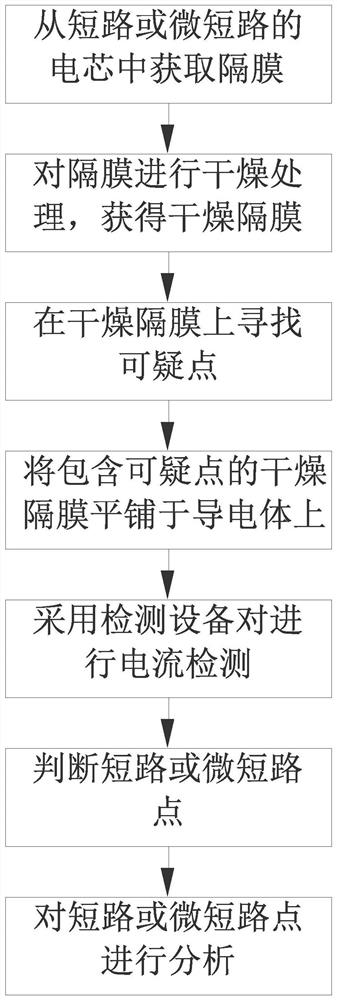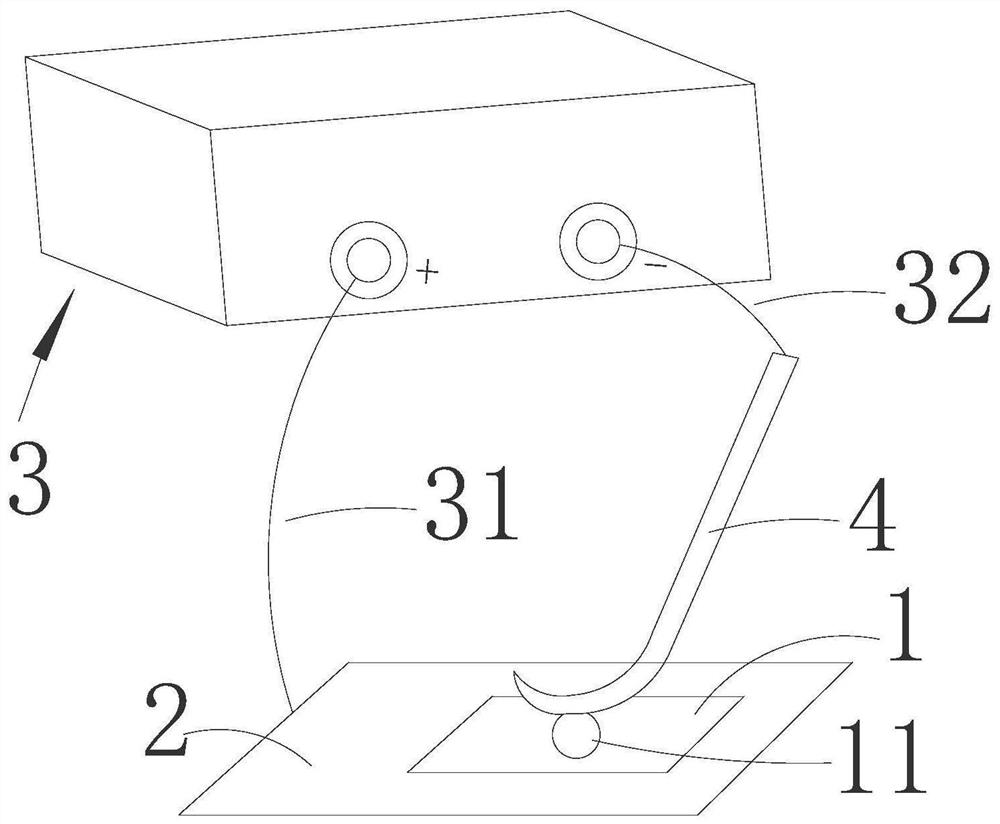Lithium-ion battery short circuit test method
A lithium-ion battery and short-circuit testing technology, which is applied in short-circuit testing, discharge tube testing, and dielectric strength testing, can solve problems such as analysis and failure to perform root causes, and achieve low cost, quantitative analysis, and simple and convenient operation Effect
- Summary
- Abstract
- Description
- Claims
- Application Information
AI Technical Summary
Problems solved by technology
Method used
Image
Examples
Embodiment 1
[0091] A method for short-circuit testing of lithium-ion batteries, comprising the following steps:
[0092] (1) Disassemble the cells with micro-short circuits and use a magnifying glass to find suspicious black spots on the diaphragm;
[0093] (2). Place the diaphragm with suspicious black spots in an oven at 45°C for 10 minutes, and then cool down to room temperature naturally after drying, and then refer to figure 2 As shown in the test schematic diagram, the drying membrane is laid flat on a clean and dry copper foil, and the surface of the drying membrane with suspicious black spots is facing up;
[0094] (3). Use copper foil to make a flat and flexible copper tube at one end;
[0095] (4). Connect one end of the Hi-pot tester to the copper tube and the other end to the copper foil. After adjusting the voltage of the Hi-pot tester to 40V, use the flat end of the copper tube to contact the suspected black spot of the drying diaphragm, and connect the Hi-pot tester to th...
Embodiment 2
[0107] A method for short-circuit testing of lithium-ion batteries, comprising the following steps:
[0108] (1) Disassemble the cells with micro-short circuits and use a magnifying glass to find suspicious black spots on the diaphragm;
[0109] (2). Place the diaphragm with suspicious black spots in an oven at 30°C for 15 minutes, and then cool down to room temperature naturally after drying, and then refer to figure 2 As shown in the test schematic diagram, the drying membrane is laid flat on a clean and dry iron plate, and the surface of the drying membrane with suspicious black spots is facing upward;
[0110] (3). Use copper foil to make a flat and flexible copper tube at one end;
[0111] (4). Connect one end of the Hi-pot tester to the copper tube and the other end to the iron plate. After adjusting the voltage of the Hi-pot tester to 30V, use the flat end of the copper tube to contact the suspected black spot of the drying diaphragm, and connect the Hi-pot tester to ...
Embodiment 3
[0123] A method for short-circuit testing of lithium-ion batteries, comprising the following steps:
[0124] (1) Disassemble the cells with micro-short circuits and use a magnifying glass to find suspicious black spots on the diaphragm;
[0125] (2). Put the diaphragm with suspicious black spots in an oven at 60°C for 8 minutes, and then cool down to room temperature naturally after drying, and then refer to figure 2 As shown in the test schematic diagram, the dry diaphragm is laid flat on a clean and dry graphite plate, and the surface of the dry diaphragm with suspicious black spots is facing up;
[0126] (3). Use copper foil to make a flat and flexible copper tube at one end;
[0127] (4). Connect one end of the Hi-pot tester to the copper tube and the other end to the graphite plate. After adjusting the voltage of the Hi-pot tester to 20V, use the flat end of the copper tube to contact the suspected black spot of the drying diaphragm, and connect the Hi-pot tester to 20V...
PUM
 Login to View More
Login to View More Abstract
Description
Claims
Application Information
 Login to View More
Login to View More - R&D
- Intellectual Property
- Life Sciences
- Materials
- Tech Scout
- Unparalleled Data Quality
- Higher Quality Content
- 60% Fewer Hallucinations
Browse by: Latest US Patents, China's latest patents, Technical Efficacy Thesaurus, Application Domain, Technology Topic, Popular Technical Reports.
© 2025 PatSnap. All rights reserved.Legal|Privacy policy|Modern Slavery Act Transparency Statement|Sitemap|About US| Contact US: help@patsnap.com



